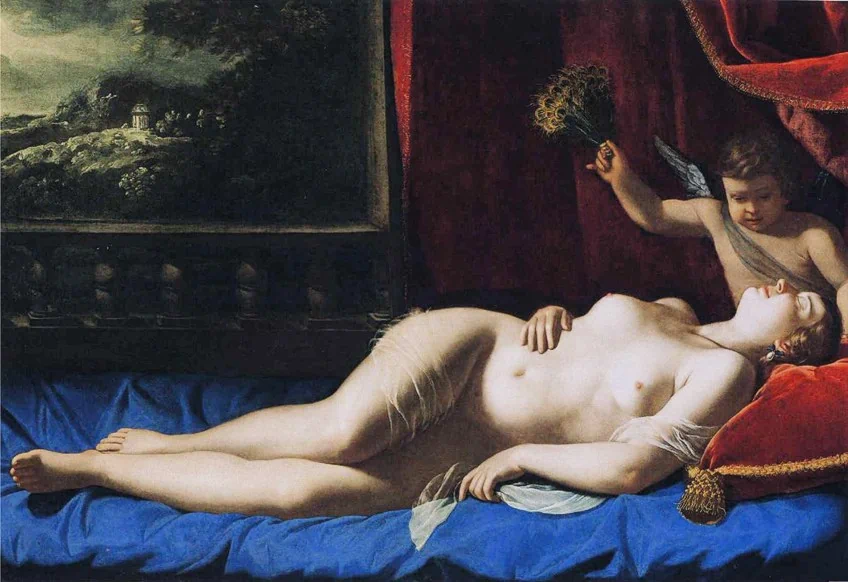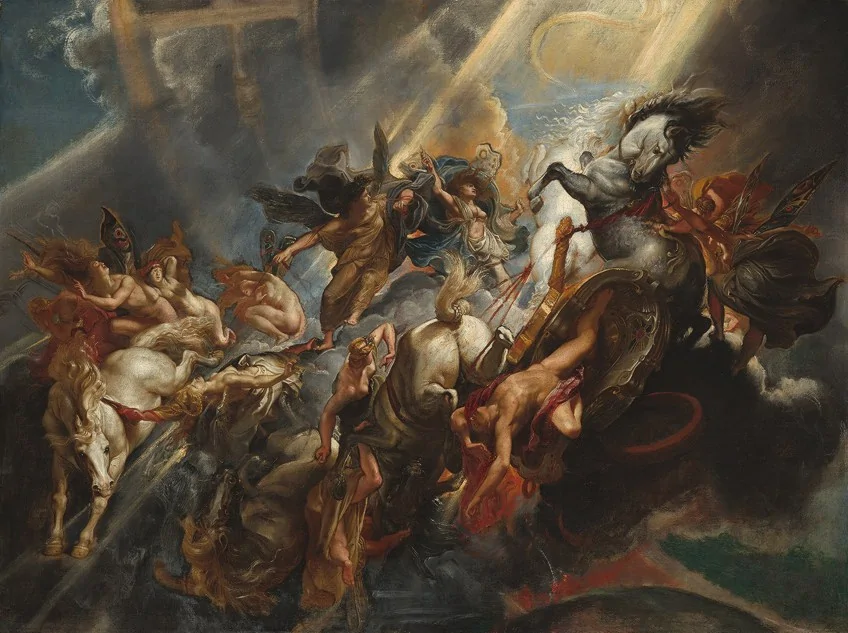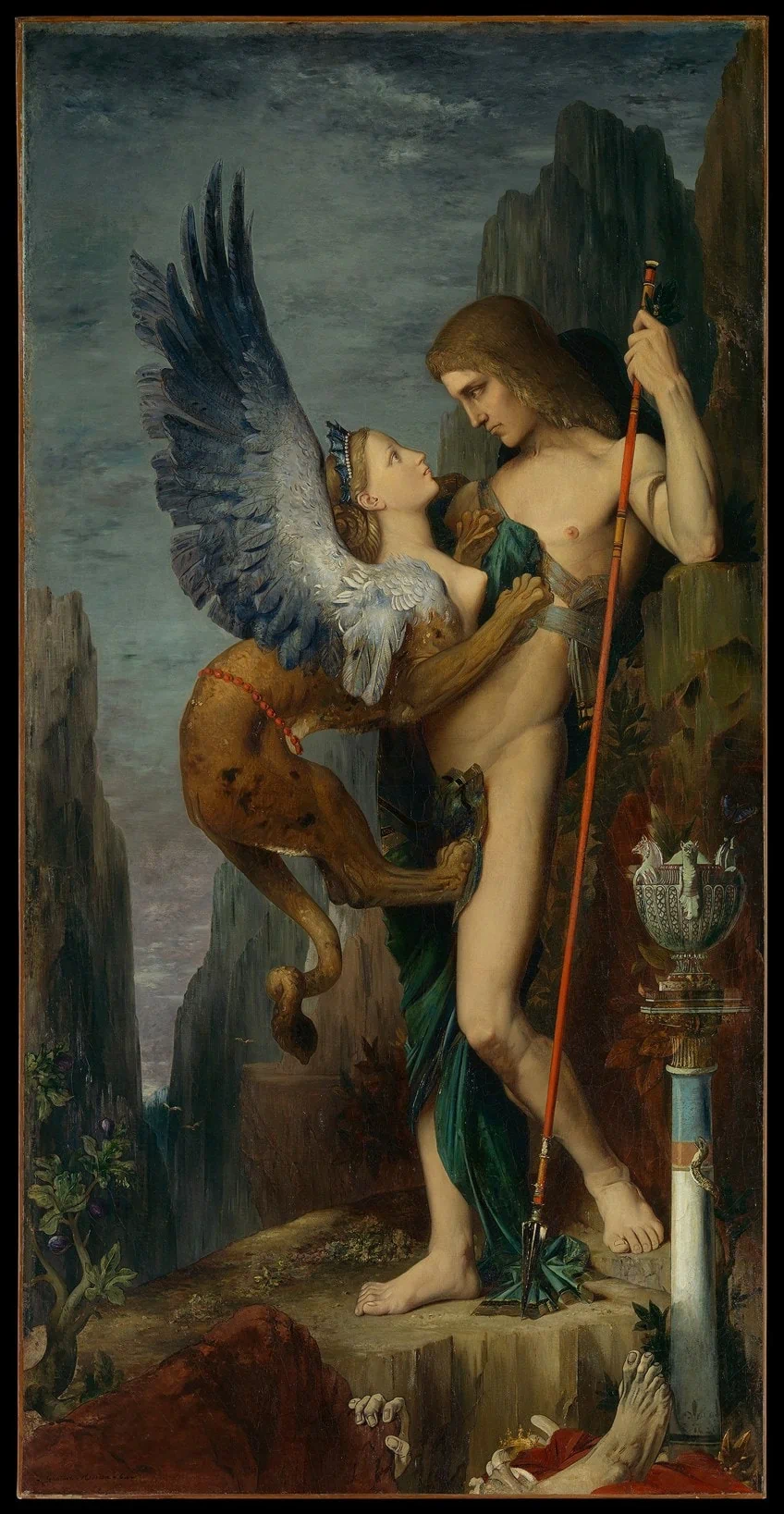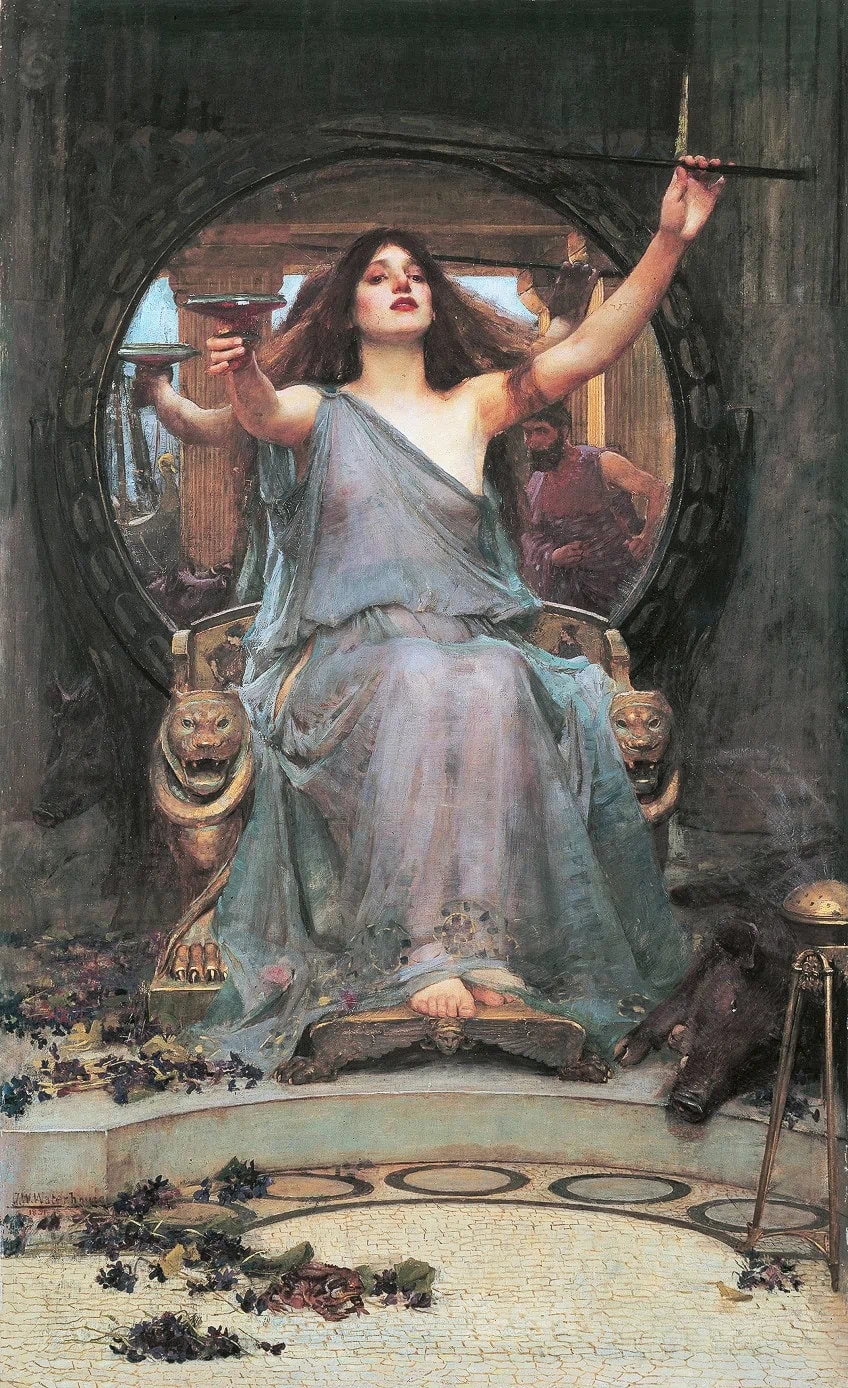Famous Greek Paintings of Gods – The Top Greek Gods Paintings
When we think of Greek mythology art, what often comes to mind are sculpted gods and mythological scenes in white marble. However, there are many famous Greek paintings of gods that have shaped how we imagine these magical stories today. For the ancient Greeks, myths formed part of their religion and explained the origins of the many gods and goddesses they worshipped and their relationship with mankind. Each character in these myths had a distinct personality and realm over which they ruled, fascinating not only to the ancient Greeks but to people from around the world today.
Why Did Greek Mythology and Gods Become a Popular Theme in Paintings?
During the Renaissance in the 14th and 16th centuries, there was a revival of interest in classical antiquity, which set the stage for the love affair that artists and poets would have with Greek mythology during that time and later periods. Poets and artists were inspired by Ovid’s poetry and other classical writers such as Homer, which influenced how Greek mythology was perceived for centuries.
The word renaissance means “rebirth” and was an important time of artistic, cultural, economic, and political developments in Europe after the Middle Ages.

During this time, Greek Renaissance art was influenced by a cultural movement known as Humanism, an ancient Greek tradition in which the human experience is placed in the center of events rather than the gods. Humanism encouraged people in Europe to question religion and the world around them. Greek mythology and gods intrigued people because the stories were relatable as well as revered.
The Greek gods have human characteristics as they were created in the image of human beings, and their stories contain important lessons and morals that are relevant even today.
The Ten Most Famous Greek Mythology Paintings
As a subject that has found its way into music, poetry, as well as contemporary popular culture, Greek mythology has inspired many painters, including Caravaggio, Rubens, Botticelli, and Moreau, to name but a few. Below, we list the 10 most famous Greek paintings of gods and mythology from Greek Renaissance art and later periods in history.
Pallas and the Centaur (1480 – 1485) by Sandro Botticelli
| Artist | Sandro Botticelli (1445 – 1510) |
| Date Painted | 1480 – 1485 |
| Medium | Tempera on canvas |
| Dimensions (cm) | 207 x 148 |
| Where It Is Currently Housed | Uffizi Gallery |
Sandro Botticelli was a Florentine painter and draughtsman during the early Renaissance and was one of the most respected artists in Italy. Pallas and the Centaur is one of several mythological works painted by him and it may include hidden references to the Christian religion. Pallas is associated with the goddess Athena, the goddess of war strategy and wisdom, although the female figure may also be Camilla, a virgin who died in battle while fighting for her country.
The centaur is a creature that is part man and part beast, often symbolizing the raw passion and wild instincts of humanity.

Historians and critics have argued as to the meaning of the painting. Some believe that the combination of Pallas and the Centaur is an allegory for balance and control. In the work, the female figure is holding a battle ax and is pulling the centaur by the hair, perhaps taming the beast. She is beautifully dressed and decorated in the three-ring insignia of the Medici family, who commissioned the painting.
She is covered with plant shoots which may be the olive associated with Pallas, or myrtle, associated with Camilla.
The Triumph of Galatea (1514) by Raphael
| Artist | Raphael (1483 – 1520) |
| Date Painted | 1514 |
| Medium | Fresco |
| Where It Is Currently Housed | Villa Farnesina |
Raffaello Sanzio da Urbino, known as Raphael, was a High Renaissance Italian painter and architect. The Triumph of Galatea depicts Galatea, the goddess of calm seas, and the Nereides or sea nymphs. She was wooed by the giant, Polyphemus, but she rejected his advances and instead fell in love with a peasant shepherd named Acis. Polyphemos, blinded with jealousy and anger after seeing the two lovers together, crushed Acis with a rock. Heartbroken, Galatea then transformed Acis into a stream of water.
The Triumph of Galatea is a fresco, a technique of mural painting done using water-based pigments on freshly laid plaster.

In this painting, Raphael did not depict any singular event from the story. Galatea is shown riding on a shell-like chariot drawn by two dolphins and surrounded by other sea creatures, while a nymph is being abducted by a Triton on the left of the work.
The vibrant colors and decoration used are said to be inspired by ancient Roman paintings.
Narcissus (1597 – 1599) by Michelangelo Merisi da Caravaggio
| Artist | Michelangelo Merisi da Caravaggio (1571-1610) |
| Date Painted | 1597–1599 |
| Medium | Oil on canvas |
| Dimensions (cm) | 110 x 92 |
| Where It Is Currently Housed | Galleria Nazionale d’Arte Antica |
Caravaggio was an Italian painter and one of the most innovative artists during the Renaissance and Baroque periods. Narcissus has been retold many times in literature and became a popular theme for writers such as Dante and other Renaissance artists. Narcissus, a very beautiful hunter from Thespiae in Boeotia, was well-known for his looks. One day, while he was hunting, Narcissus became thirsty and leaned toward the water to drink. As he did so, he became mesmerized by his own reflection.
He fell in love with the image and was unable to leave. But his love could not be reciprocated, and he died, turning into a white and gold flower.

This painting by Caravaggio depicts Narcissus staring into his own reflection in the water, which is flat like a mirror. He is wearing a brocade doublet, a garment often worn by men since the 15th and 17th centuries. The strong use of light and shadow in the painting creates a dark atmosphere around the figure, making him the focal point of the work and creating a feeling of melancholy.
It is interesting to note that the word “narcissist” originates from this story, written by the Roman poet Ovid in Metamorphoses (Book III) (8 CE).
Leda and the Swan (1598 – 1600) by Peter Paul Rubens
| Artist | Peter Paul Rubens (1577 – 1640) |
| Date Painted | 1598 – 1600 |
| Medium | Oil on panel |
| Dimensions (cm) | 64.5 x 80.5 |
| Where It Is Currently Housed | Collection of Museum of Fine Arts |
Leda and the Swan was one of two paintings that the Flemish Baroque painter, Peter Paul Rubens, created on the same subject. He was greatly inspired by Michelangelo after being introduced to his work during a visit to Italy. The tale of Leda and the Swan is wrapped in scandal.
According to legend, the god, Zeus, transformed into a swan and tricked Leda into sleeping with him on the same night that she did with Tyndareus, her husband the King of Sparta.

Later, Leda gave birth to two children of Zeus, Helen and Polydeuces, while at the same time bearing two children of Tyndareus, Castor and Clytemnestra. Stories of women being abducted or seduced by mythological beings became a recurring theme in paintings during the Renaissance and Baroque periods.
Here, Leda is portrayed nude as the swan is cradled between her legs and breasts, caressing her intimately and kissing her lips with its beak.
The swan is depicted as graceful, an animal that would not usually be thought of as taking advantage of a woman. Leda’s body is curved and twisted, creating movement within the painting, while her hands are reminiscent of Michelangelo’s style.
The Fall of Phaeton (1604 – 1605) by Peter Paul Rubens
| Artist | Peter Paul Rubens (1577 – 1640) |
| Date Painted | 1604 – 1605 |
| Medium | Oil on canvas |
| Dimensions (cm) | 98.4 x 131.2 |
| Where It Is Currently Housed | The National Gallery of Art, Washington, D.C. |
Another famous painting by Peter Paul Rubens is The Fall of Phaeton, a myth that has been a recurring subject in art. Phaeton was the son of Helios, the sun god, and Clymene, who was an Oceanid. Phaeton begged his father to allow him to drive the sun chariot through the sky, and Helios finally conceded. Phaeton was unable to control the bolting horses and keep them on the course, driving the chariot towards the earth.
To prevent destruction, Zeus threw a thunderbolt at him and he fell to his death.

The tragedy portrayed in this painting is achieved through light and shadow, with the calamity of figures writhing in fear and panic. The butterfly-winged women around Phaeton represent the seasons and the hours of day and night, their reaction further indicating disharmony and terror as flames cover the earth below.
Phaeton’s rash behavior led to destruction and this story appealed to many artists, as it was seen as a moral lesson on the consequences of pride.
Oedipus and the Sphinx (1864) by Gustave Moreau
| Artist | Gustave Moreau (1826 – 1898) |
| Date Painted | 1864 |
| Medium | Oil on canvas |
| Dimensions (cm) | 206 x 105 |
| Where It Is Currently Housed | Metropolitan Museum of Art |
Painted by the French artist Gustave Moreau, Oedipus and the Sphinx depicts the two meeting on the path to Delphi, as portrayed by Sophocles in his play Oedipus Rex (1864). Oedipus found that the city of Thebes had been subjugated by the Sphinx after the king, Laius had been killed. Oedipus could not pass on to Delphi unless he solved the riddle given to him by the Sphinx. If he failed to solve it, Oedipus and the Thebans would die.
Fortunately, he answered the riddle correctly and the Sphinx hurled herself into the sea. Thereafter, Oedipus became the king of Thebes.

This painting is not as realistically portrayed as other works painted during the mid-19th century as Moreau took on a more archaic style in depicting the mythological subject matter. In this scene, we see the Sphinx aggressively clawing at Oedipus while he stands in the classical contrapposto posture.
This painting marked a pivotal moment in Moreau’s career after it was presented at the Paris Salon in 1864.
Pygmalion and Galatea (1890) by Jean-Léon Gérôme
| Artist | Jean-Léon Gérôme (1824 – 1904) |
| Date Painted | 1890 |
| Medium | Oil on canvas |
| Dimensions (cm) | 89 x 67 |
| Where It Is Currently Housed | The Metropolitan Museum of Art |
Pygmalion and Galatea was painted by the French artist and sculptor, Jean-Léon Gérôme. Unlike many of his contemporaries, Gérôme was not involved with the popular movements of the 19th century such as Impressionism. In this painting, he depicts a moment from Ovid’s poem, Metamorphoses (8 CE). In the poem, the lonely sculptor Pygmalion sculpts his ideal version of the female figure, Galatea, who is brought to life by the goddess Aphrodite.
In this scene, Pygmalion embraces and kisses Galatea the moment she wakes.
Pygmalion and Galatea (1890) by Jean-Léon Gérôme, located in the Metropolitan Museum of Art in New York City, United States; Jean-Léon Gérôme, CC0, via Wikimedia Commons
This work is one of three paintings of the same scene painted by Jean-Léon Gérôme. In each one, the sculpture is seen from a different angle. Pygmalion and Galatea is painted in a detailed and realistic style, similar to many of Gérôme’s other works.
It is thought that the studio featured in the painting is the artist’s own studio.
Perseus and Andromeda (1891) by Frederic Leighton
| Artist | Frederic Leighton (1830 – 1896) |
| Date Painted | 1891 |
| Medium | Oil on canvas |
| Dimensions (cm) | 235 x 129,2 |
| Where It Is Currently Housed | Walker Art Gallery |
Frederic Leighton was an English 19th-century artist. Perseus and Andromeda is one of his most famous works, depicting the moment Andromeda is attacked by a sea monster. Andromeda was the beautiful daughter of Cassiopeia and Cepheus, the queen and king of Aethiopia.
When the queen claimed that she was more beautiful than the sea nymphs, the daughters of Poseidon, the sea god sent a punishment in the form of a sea monster to destroy the coast of Aethiopia.

Cepheus and Cassiopeia decided to sacrifice their daughter to the monster as an offering by shackling her to a rock at the edge of the water. Perseus rescued Andromeda and killed the monster. In this painting, Andromeda is painted in light colors and white tones to emphasize her innocence. Perseus is depicted the same way as he flies to the rescue riding Pegasus, his winged horse.
Leighton’s style often included large amounts of detail and movement, which created a dramatic effect.
Circe Offering the Cup to Ulysses (1891) by John William Waterhouse
| Artist | John William Waterhouse (1849 – 1917) |
| Date Painted | 1891 |
| Medium | Oil on canvas |
| Dimensions (cm) | 149 x 92 |
| Where It Is Currently Housed | Oldham Art Gallery |
Circe Offering the Cup to Ulysses was painted by the pre-Raphaelite Romanticist painter, John William Waterhouse, who was inspired by Homer’s Odyssey (725 – 675 BCE). Circe, the goddess of sorcery, transformed humans into animals by serving them a potion. Circe had used the same potion on Ulysses’ crew while he was not present, turning them into pigs.
She intended on doing the same to Ulysses, but Hermes intercepted him, telling him to collect a special plant that resists the effects of Circe’s potion.

After he drank the potion, Circe touched him with her wand to complete the transformation, but then Ulysses drew his sword and she begged for his forgiveness. In this painting, Waterhouse depicts Circe with the potion in one hand and her wand in the other. She is surrounded by purple flowers and her dress is also purple, signifying royalty. She sits on a throne with a pig to the right of her feet, one of the crew members. A reflection of Ulysses can be seen in the mirror behind her.
The scene is realistically rendered with much attention to detail and symbolism.
The Lament for Icarus (1898) by Herbert James Draper
| Artist | Herbert James Draper (1863 – 1920) |
| Date Painted | 1898 |
| Medium | Oil on canvas |
| Dimensions (cm) | 180 x 150 |
| Where It Is Currently Housed | Tate Britain |
Herbert James Draper was an English Classicist artist who painted between the 19th and 20th centuries. His work, The Lament for Icarus, is considered one of his greatest paintings. Icarus was the son of the inventor Daedalus, who made wings for them to fly away from the island on which they were imprisoned.
In a moment of exhilaration, Icarus forgot his father’s warnings and flew dangerously close to the sun, melting the wax that secured the wings and he dropped to the sea.

Draper chose to center the painting on the moment after Icarus died. He is surrounded by sea nymphs, with his glorious wings splayed out over the rocks. Draper represented the wings still attached to Icarus’ body, which may have been done to achieve a romantic heavenly appearance. Although it is a tragic scene, the artist used mainly warm colors, with the setting sun in the background symbolizing the brevity of time.
Greek mythology art and Greek gods paintings have had an impact on the way we understand and think of their dramatic and inspiring stories and will continue to do so. The paintings listed above visually educate viewers on the lessons that these myths teach, portraying the consequences of choice and passion. There are many masterpieces exploring this theme and if you have felt inspired by the 10 artworks above, we encourage you to continue your exploration into the world of famous Greek paintings of gods, goddesses, and mythical creatures.
Frequently Asked Questions
What Is a Myth?
A myth can be understood as a story of a god or human with powerful and unusual abilities involved in extraordinary events. It is often connected with a heroic adventure that takes place in an unknown period but is associated with the distant past.
Why Is Greek Mythology Important in Art?
Greek mythology has been represented in art since the late Mycenaean period (1750 – 1050 BC). Artists since then have been inspired by these works, producing various versions of the same myths. The ancient Greeks used art as a way of honoring their gods and can be understood as a visual record. Greek mythology is important in art not only because of its inspiring tales filled with relevant lessons, but it keeps this record alive through every artist’s re-interpretation of the myths.
Jaycene-Fay Ravenscroft is a writer, poet, and creative based in South Africa, boasting over 6 years of experience working in a contemporary art gallery. She earned her Bachelor of Arts degree with majors in Art History and Ancient History from the University of South Africa, supplementing her studies with courses in Archaeology and Anthropology. Driven by a passion for learning, Jaycene-Fay finds inspiration in symbology and the interconnectedness of the world. Trained to analyze and critique art, she is enthusiastic about delving into the meanings behind each artwork, exploring its ties to the artist’s cultural, historical, and social context. Writing serves as Jaycene-Fay’s means of researching, sharing knowledge, and creatively expressing herself. For artfilemagazine, Jaycene-Fay writes articles on art history with a focus on historical paintings.
Learn more about Jaycene-Fay Ravenscroft and about us.
Cite this Article
Jaycene Fay, Ravenscroft, “Famous Greek Paintings of Gods – The Top Greek Gods Paintings.” artfilemagazine – Your Online Art Source. August 9, 2022. URL: https://artfilemagazine.com/famous-greek-paintings-of-gods/
Ravenscroft, J. (2022, 9 August). Famous Greek Paintings of Gods – The Top Greek Gods Paintings. artfilemagazine – Your Online Art Source. https://artfilemagazine.com/famous-greek-paintings-of-gods/
Ravenscroft, Jaycene Fay. “Famous Greek Paintings of Gods – The Top Greek Gods Paintings.” artfilemagazine – Your Online Art Source, August 9, 2022. https://artfilemagazine.com/famous-greek-paintings-of-gods/.




Excellent presentation, brief but with multiple messages, of a journey into the magical world of mythology.